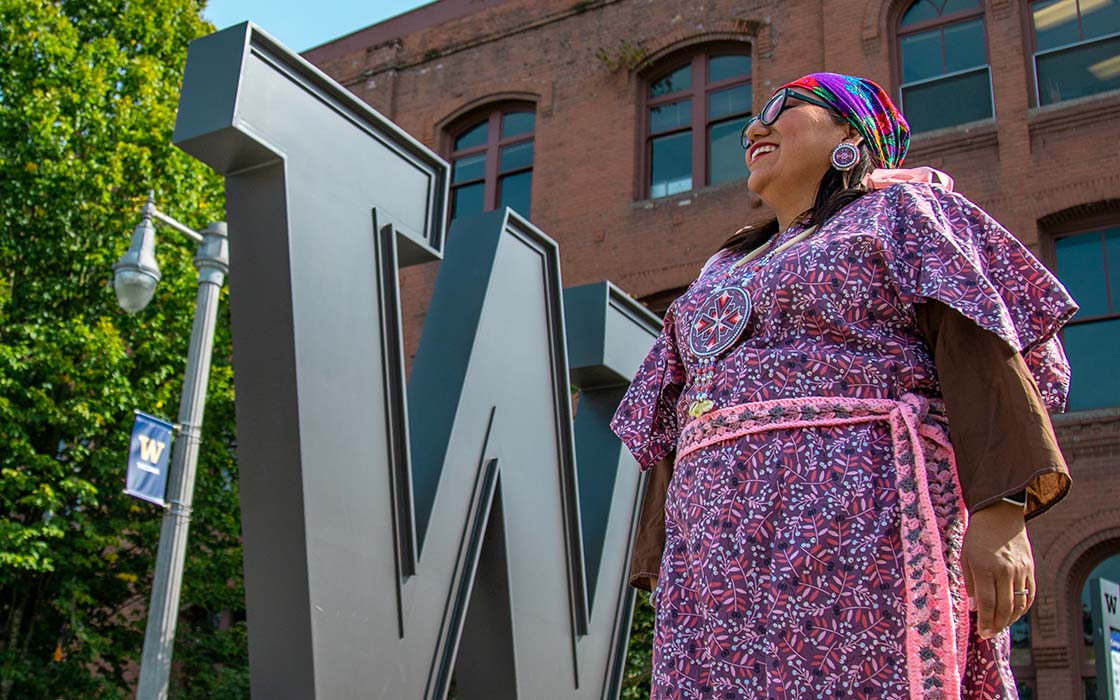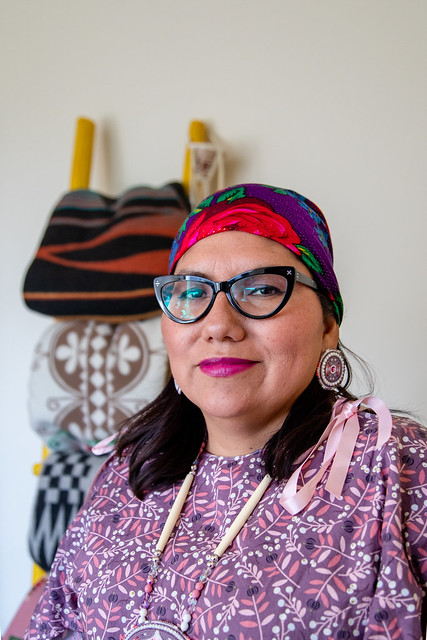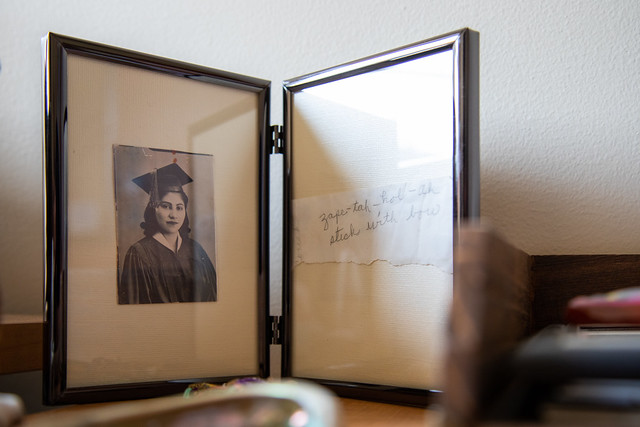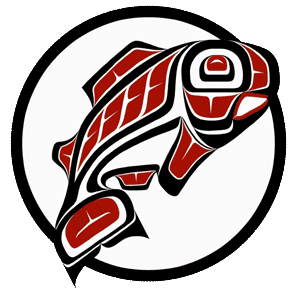
Making a Name for Herself
Robin Starr Zape-tah-hol-ah Minthorn brings an Indigenous perspective to the School of Education.
This Section's arrow_downward Theme Info Is:
- Background Image: ""
- Theme: "light-theme"
- Header Style: "purple_dominant"
- Card Height Setting: "consistent_row_height"
- Section Parallax: "0"
- Section Parallax Height: ""
Robin Starr Zape-tah-hol-ah Minthorn (Kiowa Tribe of Oklahoma, Apache, Nez Perce, Umatilla and Assiniboine) has held onto a scrap of paper for 15 years. The paper is small, no more than three inches long by two inches wide. Minthorn, the new Director of the Educational Leadership Doctoral Program in the School of Education, keeps the bit of parchment in a frame at the corner of her desk next to a black and white photo of her grandmother, Roxie Kodaseet Tsotigh.

The photo is a fairly standard high school graduation portrait. There’s the requisite headshot and uncomfortable smile of being asked to grin on command. This ubiquitous, picture-day comb moment is familiar — except it’s not. This image comes from what is now Haskell Indian Nations University which started out as an Indian boarding school.
Boarding schools were an attempt to separate Indigenous children from their culture, communities and families. The notorious statement, “kill the Indian, save the man,” comes from this period and speaks to the goal of these schools and the larger U.S. government policy of forced assimilation and genocide.
Minthorn is a member of the Kiowa tribe as was her grandmother. “Both she and my grandfather were Christian,” said Minthorn. “They, and others in my community, were forced to give up their beliefs if they were to convert to Christianity.”
Returning to Minthorn’s office and the strip of framed paper. Tribal names and naming ceremonies were among the many things Indigenous peoples in the United States were made to give up. “When I was in my early twenties, I told my grandmother I wanted a Kiowa name,” said Minthorn.
Zape-tah-hol-ah means “sticks with bows.” The name belonged to Minthorn’s great grandmother, Bessie Catherine Kokoom. “I went with my mother and grandmother to Hobart, Oklahoma to visit a cousin who gave us background on the name and showed us how to write it — then he had my grandma write it out on a piece of paper.”
This is the paper Minthorn keeps safely ensconced behind glass. There, in sprawling script, is the name “Zape-tah-hol-ah.” Minthorn’s grandmother passed away in 2012. “I wanted to do something to honor her memory,” said Minthorn. On her right forearm is a tattoo of a bow with Zape-tah-hol-ah written underneath. “That’s actually my grandmother’s writing,” said Minthorn.
Struggles & Success
Minthorn grew up in Oklahoma. She primarily lived with her grandparents during high school. “They lived in a rural town that had a high Native student population,” said Minthorn. “I would stay with them during the week then on the weekends I’d go back to my mom’s house.”
A self-described “good student,” Minthorn excelled in high school. “I finished with 3.7 GPA,” she said. Following graduation, Minthorn enrolled at The University of Oklahoma in Norman. “I quickly realized that the success I had in high school didn’t correlate to what I needed to do in college.”
A first-generation student, Minthorn struggled early in her college career. “I ended up on academic probation at the end of my freshman year,” she said. Minthorn’s GPA reflected her lack of experience and support systems she could utilize to succeed in higher education. “I didn’t understand that for some classes you have to raise the bar higher,” she said. “The other big issue was finding a balance between school work and social life.”
Minthorn’s grades steadily improved during her sophomore year. At the same time she and a group of Indigenous students at The University of Oklahoma began researching ways to help Native students persevere to graduation. “UCLA had a very well-known retention program for Native students,” said Minthorn. The group raised money to visit UCLA. The knowledge they brought back enabled them to start something similar on their own campus. “We were able to create a peer-mentoring retention program,” said Minthorn. “It was a tiered system where a freshman or sophomore would have the support of a junior or senior.”
Minthorn earned a bachelor’s in psychology then went straight into a master’s program for human relations. Afterwards, she took a break from academia and became an adviser at a for-profit institution. “I definitely felt passionate about creating support resources and helping people navigate higher education,” she said. This commitment to demystifying college lead Minthorn to work as the Coordinator for Native American Affairs at Oklahoma State University and as an academic advisor with Comanche Nation College.
Minthorn returned to The University of Oklahoma to pursue a masters in adult and higher education. In 2012, she completed her Ph.D. in Educational Leadership and Policy Studies from Oklahoma State University. Later that year she started at University of New Mexico in a dual role as both an Assistant Professor in Educational Leadership and Native American Studies. She also served as Program Coordinator of the Native American Leadership in Education (NALE) doctoral cohort.
Respect, Relationships, Collaboration
Minthorn came to UW Tacoma this past August after seven years with the University of New Mexico. She took over as Director of the Educational Leadership doctoral program from Ginger MacDonald. “Right now I’m going over historical documents as well as meeting with current students and community partners,” said Minthorn. “Really I’m just assessing where we’re at, what we’ve done and what we need to do better.”

Any long-term vision will be guided by Minthorns core principles. “For me it’s about respect, relationships and collaboration,” she said. “Those are the three values that are at the center of how I lead and who I am as a person.”
Besides guiding the doctoral program, Minthorn will also teach and conduct research. In the past Minthorn has written papers about decolonizing higher education and promoting Native student voices at colleges and universities. She is currently working on multiple projects including a book with some of her colleagues about Indigenous motherhood in academia. “We’re talking about how we balance our motherhood roles in terms of our work but also in terms of how we honor or cultural, tribal and familial responsibility,” said Minthorn.
Community is important to Minthorn and this philosophy informs how she teaches. “I see myself as the facilitator and we all co-learn together,” she said. “Within my tribe we have elders who hold a lot of knowledge and we definitely honor them in that role, but even those elders are still learning from younger people.”
Full Indigenous Self
Minthorn has mostly settled into her new office. A different piece of paper is framed, not in glass, but in hard plastic. The name placard outside Minthorn’s door in West Coast Grocery reads Robin Starr Zape-tah-hol-ah Minthorn (Kiowa Tribe of Oklahoma, Apache, Nez Perce, Umatilla and Assiniboine). Her university-issued business cards say the same thing. A delighted Minthorn took to social media. “This is the first time in my life all of my tribes and my Kiowa named have been listed,” she said. “I am so excited about this work and bringing my full Indigenous self into my role at UWT.”
Recent news
Main Content
Gathering Strength
News Tags on this arrow_upward Story:
- None
Main Content
UW Tacoma Enrollment up 4% for Autumn 2024
News Tags on this arrow_upward Story:
- None
Main Content
Celebrating First Gen
News Tags on this arrow_upward Story:
- None



